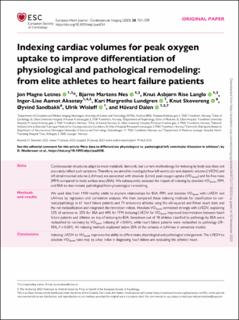| dc.contributor.author | Letnes, Jon Magne | |
| dc.contributor.author | Nes, Bjarne Martens | |
| dc.contributor.author | Langlo, Knut Asbjørn Rise | |
| dc.contributor.author | Lundgren, Kari Margrethe | |
| dc.contributor.author | Skovereng, Knut | |
| dc.contributor.author | Sandbakk, Øyvind Bucher | |
| dc.contributor.author | Wisløff, Ulrik | |
| dc.contributor.author | Dalen, Håvard | |
| dc.contributor.author | Aksetøy, Inger-Lise Aamot | |
| dc.date.accessioned | 2024-01-11T13:43:36Z | |
| dc.date.available | 2024-01-11T13:43:36Z | |
| dc.date.created | 2023-06-13T22:29:34Z | |
| dc.date.issued | 2023 | |
| dc.identifier.citation | European Heart Journal-Cardiovascular Imaging. 2023, 24 (6), 721-729. | en_US |
| dc.identifier.issn | 2047-2404 | |
| dc.identifier.uri | https://hdl.handle.net/11250/3111148 | |
| dc.description.abstract | Aims
Cardiovascular structures adapt to meet metabolic demands, but current methodology for indexing by body size does not accurately reflect such variations. Therefore, we aimed to investigate how left ventricular end-diastolic volume (LVEDV) and left atrial maximal volume (LAVmax) are associated with absolute (L/min) peak oxygen uptake (VO2peak) and fat-free mass (FFM) compared to body surface area (BSA). We subsequently assessed the impact of indexing by absolute VO2peak, FFM, and BSA to discriminate pathological from physiological remodeling.
Methods and results
We used data from 1190 healthy adults to explore relationships for BSA, FFM, and absolute VO2peak with LVEDV and LAVmax by regression and correlation analyses. We then compared these indexing methods for classification to normalcy/pathology in 61 heart failure patients and 71 endurance athletes using the chi-squared and Fisher exact tests and the net reclassification and integrated discrimination indices. Absolute VO2peak correlated strongly with LVEDV, explaining 52% of variance vs. 32% for BSA and 44% for FFM. Indexing LVEDV for VO2peak improved discrimination between heart failure patients and athletes on top of indexing to BSA. Seventeen out of 18 athletes classified to pathology by BSA were reclassified to normalcy by VO2peak indexing (P < 0.001), while heart failure patients were reclassified to pathology (39–95%, P < 0.001). All indexing methods explained below 20% of the variance in LAVmax in univariate models.
Conclusions
Indexing LVEDV to VO2peak improves the ability to differentiate physiological and pathological enlargement. The LVEDV to absolute VO2peak ratio may be a key index in diagnosing heart failure and evaluating the athlete’s heart. | en_US |
| dc.language.iso | eng | en_US |
| dc.publisher | Oxford University Press | en_US |
| dc.rights | Navngivelse-Ikkekommersiell 4.0 Internasjonal | * |
| dc.rights | Navngivelse-Ikkekommersiell 4.0 Internasjonal | * |
| dc.rights.uri | http://creativecommons.org/licenses/by-nc/4.0/deed.no | * |
| dc.title | Indexing cardiac volumes for peak oxygen uptake to improve differentiation of physiological and pathological remodeling: from elite athletes to heart failure patients | en_US |
| dc.title.alternative | Indexing cardiac volumes for peak oxygen uptake to improve differentiation of physiological and pathological remodeling: from elite athletes to heart failure patients | en_US |
| dc.type | Peer reviewed | en_US |
| dc.type | Journal article | en_US |
| dc.description.version | publishedVersion | en_US |
| dc.source.pagenumber | 721-729 | en_US |
| dc.source.volume | 24 | en_US |
| dc.source.journal | European Heart Journal-Cardiovascular Imaging | en_US |
| dc.source.issue | 6 | en_US |
| dc.identifier.doi | 10.1093/ehjci/jead034 | |
| dc.identifier.cristin | 2154293 | |
| dc.relation.project | Norges forskningsråd: 237887 | en_US |
| cristin.ispublished | true | |
| cristin.fulltext | original | |
| cristin.qualitycode | 2 | |

